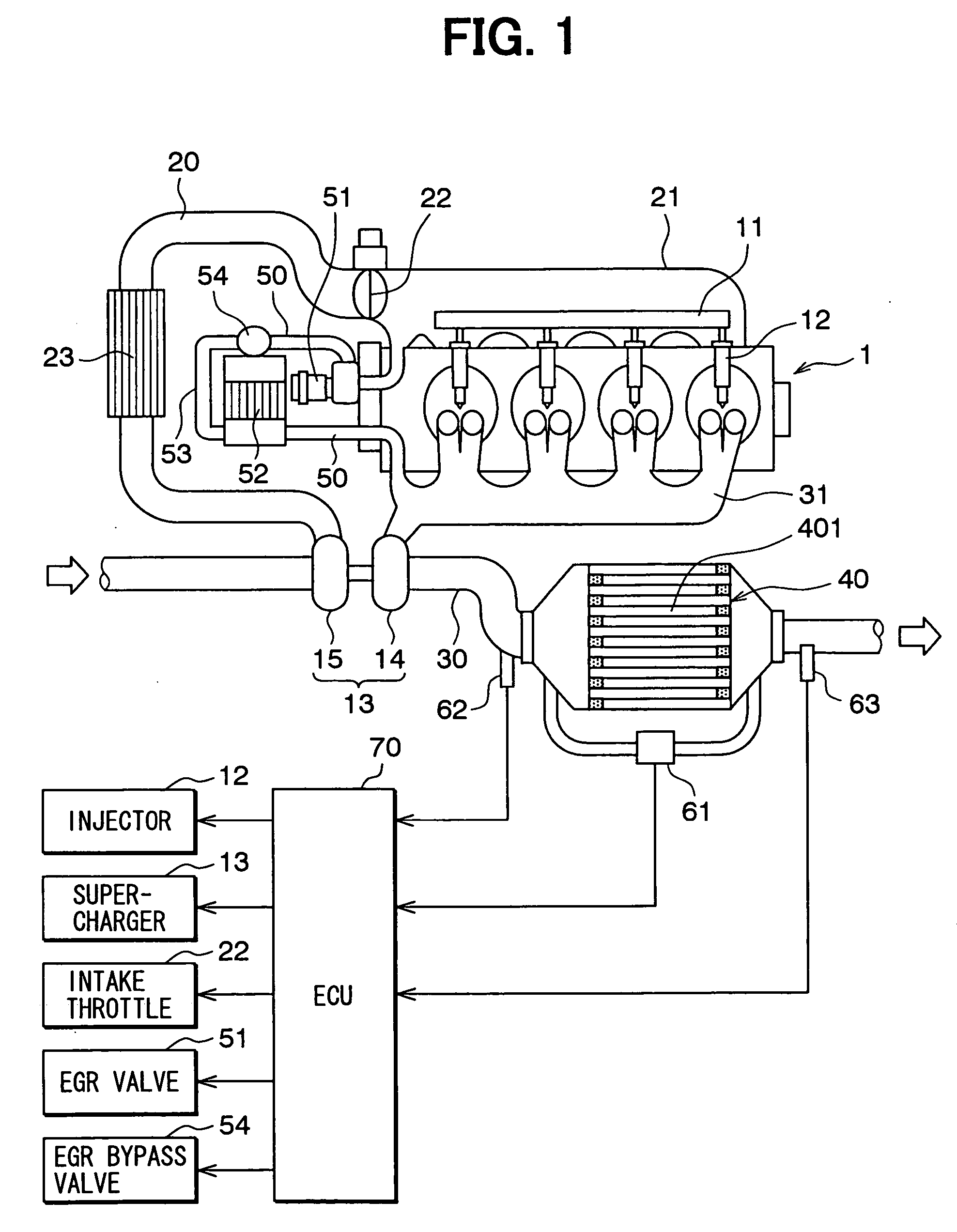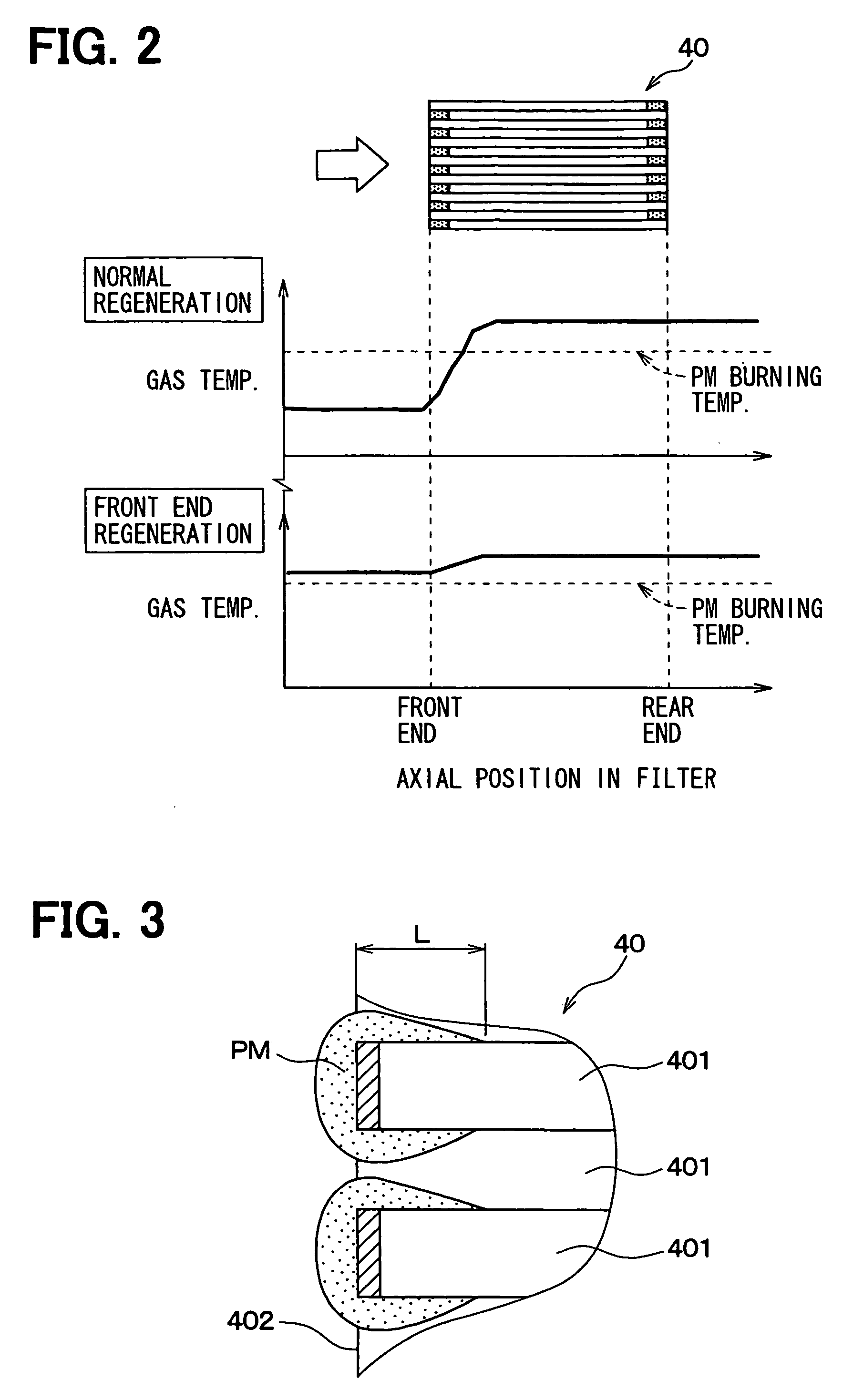Exhaust emission control system for internal combustion engine
a technology of emission control system and internal combustion engine, which is applied in the direction of electrical control, machine/engine, electric control of exhaust treatment, etc., can solve the problems of unburned hc, increased pressure loss in the particulate filter, and increased engine efficiency, so as to prevent the engine from reducing the output power
- Summary
- Abstract
- Description
- Claims
- Application Information
AI Technical Summary
Benefits of technology
Problems solved by technology
Method used
Image
Examples
first embodiment
[0025] In the following is described an exhaust emission controls system according to a first embodiment of the present invention. FIG. 1 depicts an entire construction of an internal combustion engine (hereinafter referred to just as engine) 1 that is provided with the exhaust emission control system according to the first embodiment.
[0026] The engine 1 is a water-cooled diesel internal combustion engine that is mounted on a vehicle to drive the vehicle. The engine 1 includes a common rail 11 that accumulates high-pressure fuel therein, and a plurality of fuel injection valves 12 that are connected to the common rail 11 and inject the high-pressure fuel into cylinders of the engine 1. The engine 1 drives a pump (not shown) to pressurize a fuel into the high-pressure fuel and to pressure-supply the high-pressure fuel to the common rail 11. The common rail 11 and the fuel injection valve 12 form a fuel injection apparatus that is for injecting the fuel into the cylinders of the engi...
second embodiment
[0059] In the first embodiment, the ECU 70 determines that the front end portion of the particulate filter 40 is clogged in the step S101 in FIG. 5 when the front end PM accumulation amount becomes equal to or larger than the front end clogging determination threshold value. In the second embodiment, the ECU 70 determines that the front end portion of the particulate filter 40 is clogged in another way.
[0060]FIG. 10 depicts an estimated PM accumulation amount that is accumulated in the particulate filter 40 in a non-generation time when neither the normal regeneration nor the front end portion regeneration is performed. In the drawing, a solid line indicates a first estimated PM accumulation amount, which is the PM accumulation amount in the particulate filter 40 that is estimated from the pressure difference detected by the pressure difference sensor 61 between the front portion and rear portion of the particulate filter 40. A broken line indicates a second estimated PM accumulati...
third embodiment
[0066] In the second embodiment, the ECU 70 determines that the front end portion of the particulate filter 40 is clogged based on the first estimated PM accumulation amount in the non-regeneration time and the second estimated PM accumulation amount. In the third embodiment, the ECU 70 determines whether the front end portion of the particulate filter 40 is clogged or not based on the first estimated PM accumulation amount in the normal regeneration time and the second estimated PM accumulation amount.
[0067]FIG. 11 depicts an estimated PM accumulation amount that is accumulated in the particulate filter 40 when the normal generation time is performed. In the drawing, a solid line indicates the first estimated PM accumulation amount, and a broken line indicates the second estimated PM accumulation amount.
[0068] In the normal regeneration time of the particulate filter 40, the exhaust gas temperature is relatively low in the front end portion of the particulate filter 40. Thus, eve...
PUM
 Login to View More
Login to View More Abstract
Description
Claims
Application Information
 Login to View More
Login to View More - R&D
- Intellectual Property
- Life Sciences
- Materials
- Tech Scout
- Unparalleled Data Quality
- Higher Quality Content
- 60% Fewer Hallucinations
Browse by: Latest US Patents, China's latest patents, Technical Efficacy Thesaurus, Application Domain, Technology Topic, Popular Technical Reports.
© 2025 PatSnap. All rights reserved.Legal|Privacy policy|Modern Slavery Act Transparency Statement|Sitemap|About US| Contact US: help@patsnap.com



